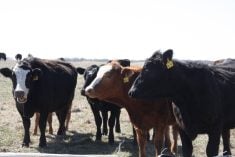This cattle market information is selected from the weekly report from Canfax, a division of the Canadian Cattlemen’s Association. More market information, analysis and statistics are available by becoming a Canfax subscriber by calling 403-275-5110 or at www.canfax.ca.
Fed sales active
Alberta direct cattle sales saw active trade last week, and steer prices trended fully steady with the previous week. A significant volume of heifers was on offer, and prices firmed $1.75 per hundredweight higher to realign comparable with steers.
Read Also

Why feds imposed EV tariffs
Moe and Kinew have a fight on their hands when it comes to eliminating the EV tariff. Canada has to worry about pissing off the U.S. and Mexico and hundreds of thousands of auto workers.
Live prices were reported from $142.25-$143.50 per cwt., and dressed sales ranged from $238.00-$240.50 per cwt. delivered. Buying competition was supportive last week, and the show list was cleaned up. The majority of trade is being scheduled for end of September delivery.
Western Canadian fed slaughter for the week ending Sept. 1 was 13 percent smaller than the previous week, totalling 40,028 head. Year-to-date western fed slaughter is seven percent larger at 1,299,812 head. Canadian steer carcass weights for the same week trended sideways at 903 pounds, three lb. lighter than a year ago.
Canadian fed/cow exports to the United States for the week ending Aug. 25 were mostly steady at 6,992 head and year to date total 237,423 head.
As for the outlook, ample market-ready fed supplies are anticipated. Feedlots continue to manage front-end supplies and have maintained marketing flexibility.
In the U.S., light to moderate fed trade developed Sept. 7 in the south with live trade from US$106-$108 per cwt., mostly steady to $1 higher than the previous week.
Heavy cow culls expected
Last week D2 cows traded from C$82-$95 per cwt. to average $88.20. D3s traded at $70-$85 to average $77.94.
Slaughter bull prices rose $1.47 last week to average $112.80.
D2 cow prices have trended sideways for the past month, averaging in the upper $80s. Last week, Alberta D2 cow prices were at a $12 per cwt. premium over the U.S. utility market.
Over the past five years (excluding 2014), the average decline from second half highs to second half lows stands at 21 percent. This historical decline suggests price risk into the mid-$70s per cwt. as a potential fall low.
Western Canadian cow slaughter volumes totalled 6,629 head, almost 2,300 head more than the same week last year. This is the seventh consecutive week that slaughter volumes have been above year-ago levels.
In drier regions of the Prairies, producers are expected to cull harder this year compared to last year. Cows that would have traditionally been kept one or two more years could be hauled to town this fall.
Steer price beats heifers
Yearling steers had a stronger week relative to their heifer counterparts. Steers weighing 800-900 lb. traded 75 cents shy of their August highs, while heifers were $5.25 per cwt. back of their highs.
Last week the 850 lb. steer cash to futures basis level was reported at +2.57 per cwt. Feeder basis levels remain historically strong, and for the beginning of September this was the second strongest basis level over the past decade.
With cow-calf pairs being gathered off summer pasture much earlier than normal, calf volumes through commercial auction facilities have been large for this time of year. Over the previous two weeks 550 lb. steers from Alberta have been averaging on either side of $225 per cwt. On a cash to cash basis, 550 lb. calf prices are at an $11 per cwt. discount to the U.S. market.
Last week Alberta and Saskatchewan steers for October delivery saw a weighted average price of $221.14 per cwt. based at 623 lb., roughly $5 per cwt. higher than three weeks ago.
Eastern Canadian buyers seem to be a bit more aggressive on the lightweight calf market this year versus last year. Eastern Canada does have a cost-of gain advantage over Western Canada. Ontario corn prices are 11 percent higher than last year, while Lethbridge barley prices are 32 percent higher.
Yearlings being priced for October delivery continue to trade at a slight premium over the spot cash market. Canadian feeder cattle exports to the U.S. totalled 1,923 head, fully steady with last year.
Beef trade eases
U.S. cut-out values eased US$3-$4.25 per cwt. lower last week with light to moderate demand observed on a moderate to heavy offering. Choice prices were down slightly at $208.75, and Select was also down, to $197.83.
U.S. steer carcass weights for the week ending Aug. 25 were three lb. larger than the previous week and two lb. heavier than the same week last year.














